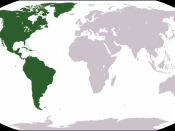About 13,000 years ago, a culture of peoples known to the archaeological world as the Clovis made a trek across the land bridge connecting modern day Alaska and their native continent of Asia. This is the accepted theory concerning habitation of the Americas, and more importantly the accepted timetable. As archeologists continue to research and dig deeper, they are finding more questions, as opposed to more answers. When did the Clovis migrate to the Americas? How did they get here? Where did they really come from? These questions have led leading researchers to conclude on one of the following theories.
The first and foremost theory is also the oldest: the "Clovis First" theory. In 1933 in Clovis, New Mexico, a stone tool is unearthed. This tool was decided to be a spearhead, as it was found in the skeletal remains of a mammoth, which was dated at 13,500 years old.
This historic artifact was come to be known as the Clovis Point, and is the oldest human artifact in the United States. Leading archaeologists believe that the last ice age, 17,000 to 24,000 year ago, resulted in a decline in the sea level. This decline exposed the continental shelf and the land bridge between Alaska and Asia. The Clovis people had migrated, most likely following the pack herd across this land bridge into Alaska. When the glaciers receded, passage was then permissible into the heart of the Americas.
Another theory, which has been considered, is that the Clovis peoples entered the Americas much earlier using a route along the West coast of Alaska, which remained unblocked by the glaciers. Excavations at a site in Medowcroft, Pennsylvania found fire pits that have been carbon dated to 16,000 BC. This evidence is bolstered by DNA research. Using DNA from the mitochondria,


